Tiered Loyalty Programs: Examples, Benefits, and Best Practices
Loyalty programs come in many shapes and sizes, but some are simply more effective at keeping customers engaged. One of the most powerful and proven approaches is the tiered loyalty program.
By rewarding customers based on their level of engagement or spending, tiered rewards programs turn everyday shoppers into brand advocates who actively strive to reach the next level. From global airlines to retail giants, leading brands use this model to motivate loyalty through recognition, exclusivity, and a clear sense of progress.
In this article, we’ll explore what tiered loyalty programs are, why they work in relation to customer behavior, which brands do them best, and the key practices that help you design a program that keeps customers coming back.
What is a tiered loyalty program?
A tiered loyalty program is a reward structure where customers earn increasing benefits as they progress through different levels or “tiers” of membership. The higher the tier, the better the rewards.
This progression is often based on measurable actions, such as total spend, purchase frequency, or engagement activities like referrals and reviews. Each tier represents a new status level, typically named to reflect exclusivity: Silver Tier, Gold Tier, Platinum Tier, or even Elite Tier.
The psychology of rewards and benefits is simple yet powerful. Customers enjoy recognition and a sense of achievement, while brands benefit from higher engagement and retention. By introducing milestones and visible progress, tiered loyalty programs encourage users to interact more frequently with the brand, spending a little extra to unlock the next level.
Tiered models deliver both short-term motivation (earning rewards now) and long-term value (striving for premium benefits later). This balance makes them one of the most effective brand loyalty strategies for driving sustained customer commitment.
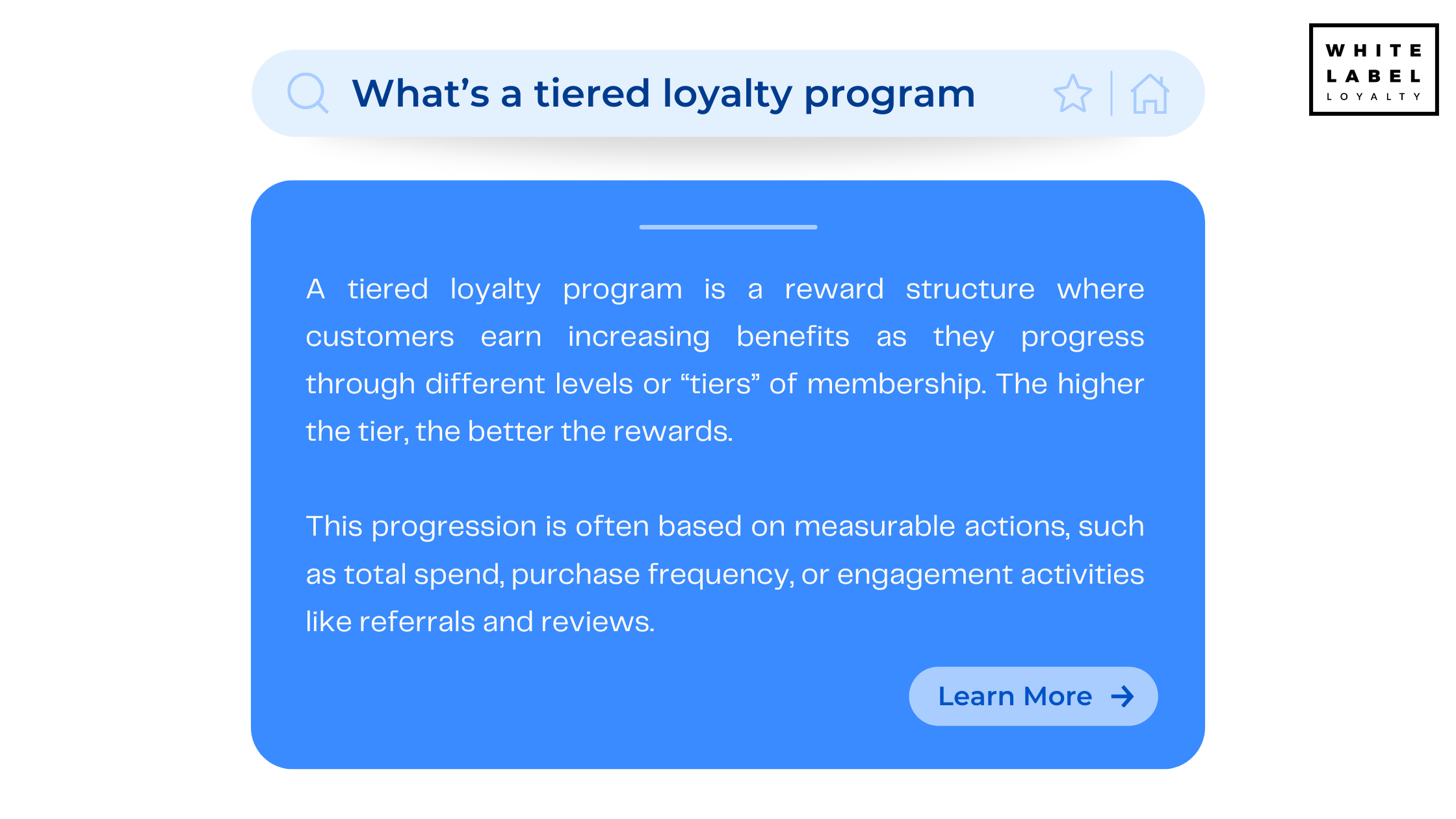
Benefits of tiered loyalty programs
When designed well, tiered loyalty programs create a win-win relationship between brands and customers. They tap into human motivation, the desire to earn recognition, reach milestones, and belong to an exclusive group, while driving measurable business results.
Here are some of the key benefits that make tiered programs so effective for loyalty program members :
1. Encourage higher engagement and spend
Each tier gives customers a reason to stay active. As members get closer to the next level, they’re motivated to make one more purchase or engage more often to unlock better rewards.
This sense of progress directly boosts average order value, purchase frequency, and customer lifetime value, metrics that matter most for long-term growth.
2. Build emotional loyalty through recognition
Customers want to feel valued by receiving exclusive benefits. Tiered programs create emotional attachment by offering status, recognition, and exclusivity.
For example, being part of a Gold or Platinum tier provides a feeling of achievement that strengthens brand connection beyond simple transactional rewards.
3. Drive long-term customer retention
Unlike basic points-based systems, tiered loyalty structures provide continuous incentives to stay engaged over time.
Members don’t want to lose their hard-earned status, so they keep interacting with the brand, renewing memberships, or maintaining purchase frequency to preserve their tier.
4. Deliver valuable customer insights
Each tier naturally segments your audience by engagement level. This helps brands understand their most loyal customers and personalise communications accordingly.
By analysing tier data, marketers can identify top spenders, rising stars, and at-risk customers, then tailor offers or experiences to keep them active.
5. Increase perceived value without heavy discounts
Tiered loyalty programs offer an appealing way to reward customers with experiential rewards rather than relying solely on discounts or cashback.
Instead, the value lies in exclusive experiences, priority access, or premium customer service, benefits that elevate your brand while protecting profit margins.
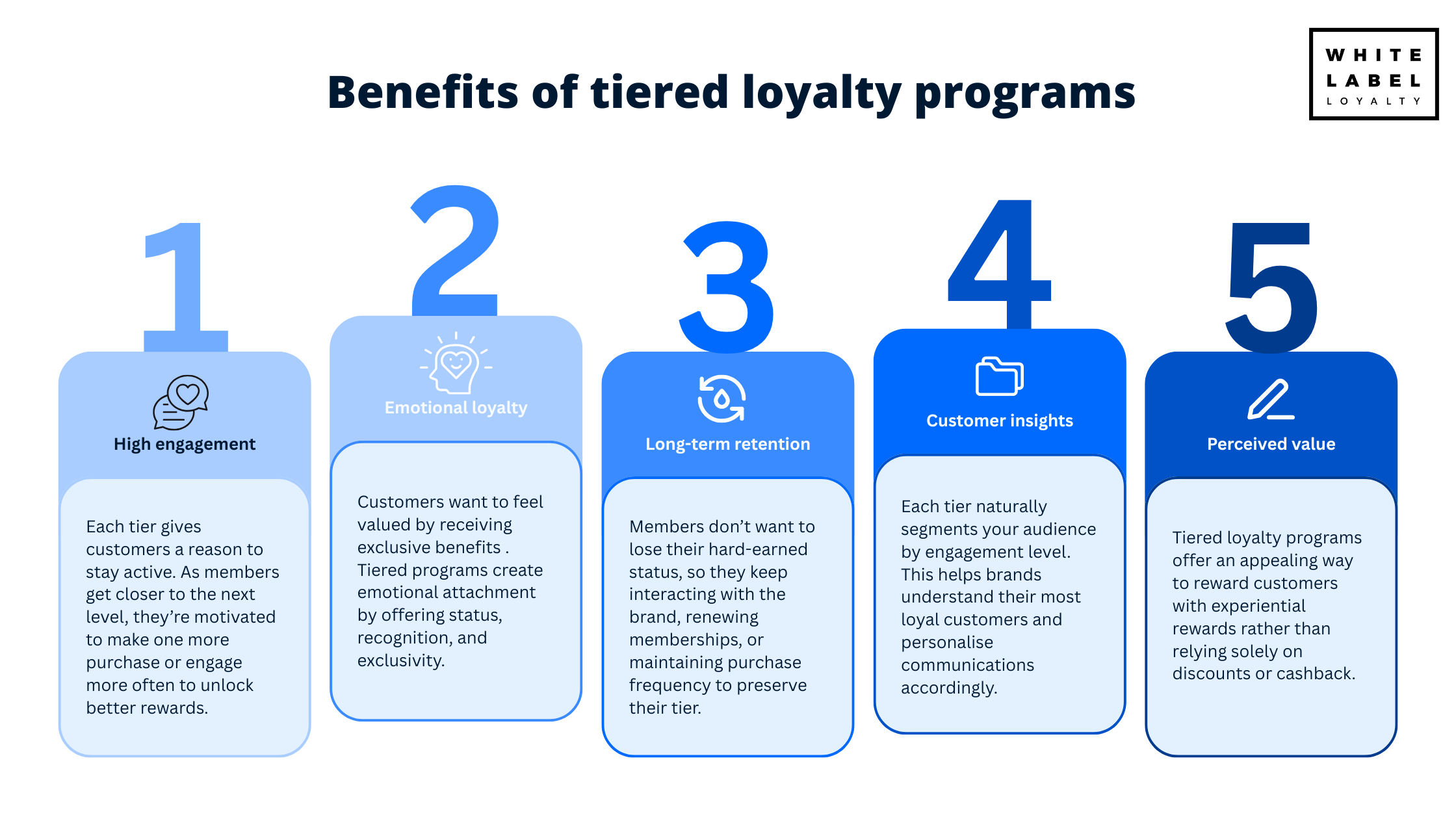
When combined with smart data tracking and clear communication, these advantages make tiered loyalty one of the most effective models for driving sustained customer engagement.
If you’re ready to take the next step, check out our guide on how to create an effective tiered loyalty program: a practical walkthrough of strategy, structure, and implementation.
Real-world examples of tiered loyalty programs
Some of the world’s most iconic brands use tiered loyalty programs to drive engagement and long-term customer value. From morning coffee runs to international flights, these examples show how flexible and powerful a tiered model can be when done right.
Starbucks Rewards: Everyday motivation through progress
Few brands understand customer motivation like Starbucks. With Starbucks Rewards, members earn Stars for every purchase, climbing through levels that unlock free drinks, birthday treats, and exclusive offers.
The app’s design makes progress tangible; customers can literally watch their next free drink get closer with every order. It’s simple, visual, and addictive in the best way.
Why it works:
Starbucks taps into goal gradient theory: the psychological principle that people work harder as they get closer to a goal. By making rewards feel achievable and progress visible, Starbucks keeps customers coming back for that next little win.

Sephora Beauty Insider: Emotional loyalty through status
Sephora’s Beauty Insider program is a lesson in how to turn customers into brand advocates through emotional connection. Its three tiers (Insider, VIB, and Rouge) don’t just offer discounts; they create a sense of belonging.
Top-tier Rouge members enjoy early access to launches, private events, and personalized experiences that make them feel part of an exclusive club.
Why it works:
Sephora understands the emotional pull of status recognition. By attaching rewards to identity and exclusivity, the brand transforms loyalty from a transactional relationship into a personal achievement.
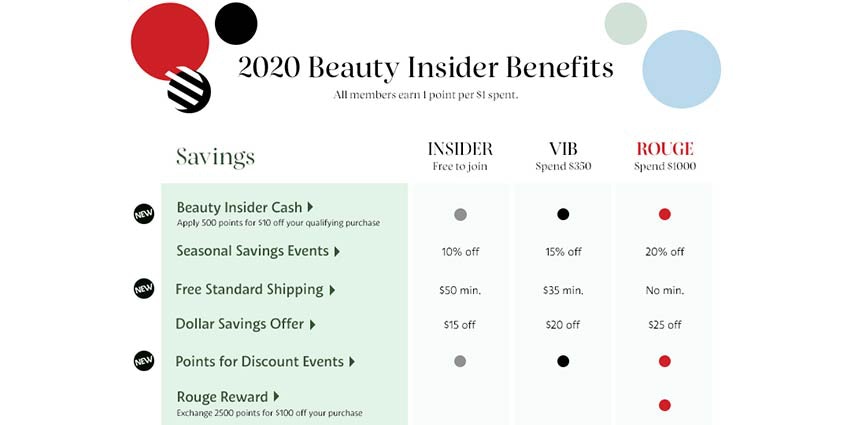
Emirates Skywards: Loyalty as prestige
Airlines have long mastered the art of loyalty through tiers, and Emirates Skywards remains one of the best examples. From Blue to Platinum, each level adds tangible travel benefits like priority check-in, lounge access, extra baggage, upgrades, creating a seamless experience for frequent flyers.
But it’s not just about convenience; it’s about prestige. The moment you flash that Platinum card, you’re recognized as a valued traveller.
Why it works:
Emirates uses social proof and recognition to elevate loyalty into a status symbol. The higher the tier, the more visible the reward, reinforcing customer pride and deepening brand attachment among high-value travellers.
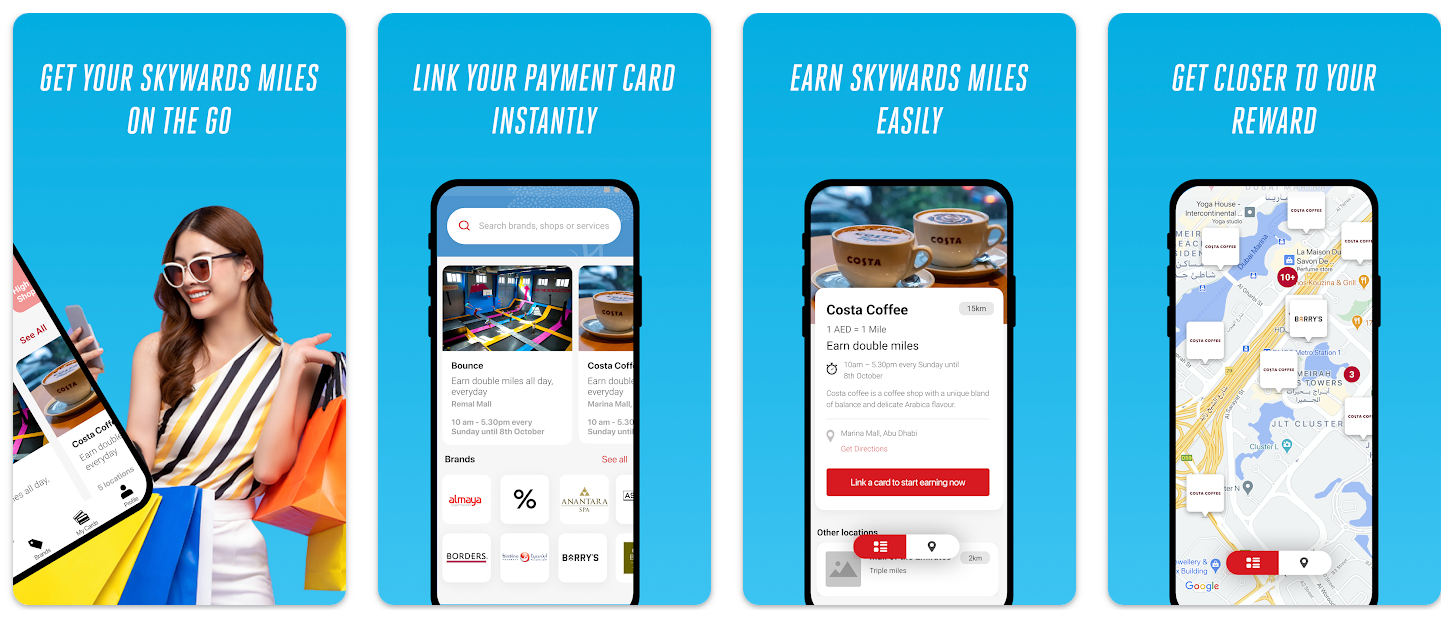
Nike Membership: A modern take on engagement tiers
Nike’s loyalty model breaks the mold by focusing on engagement rather than spend. Members earn access, rather than just points. The more they interact with the brand through the app, events, or workouts, the more exclusive products, training, and community benefits they unlock.
It’s a dynamic approach that mirrors tiered progression while celebrating participation and lifestyle alignment.
Why it works:
Nike rewards identity-driven behavior, not transactions. By linking loyalty to activity and shared values, it turns customers into community members, strengthening both engagement and advocacy.
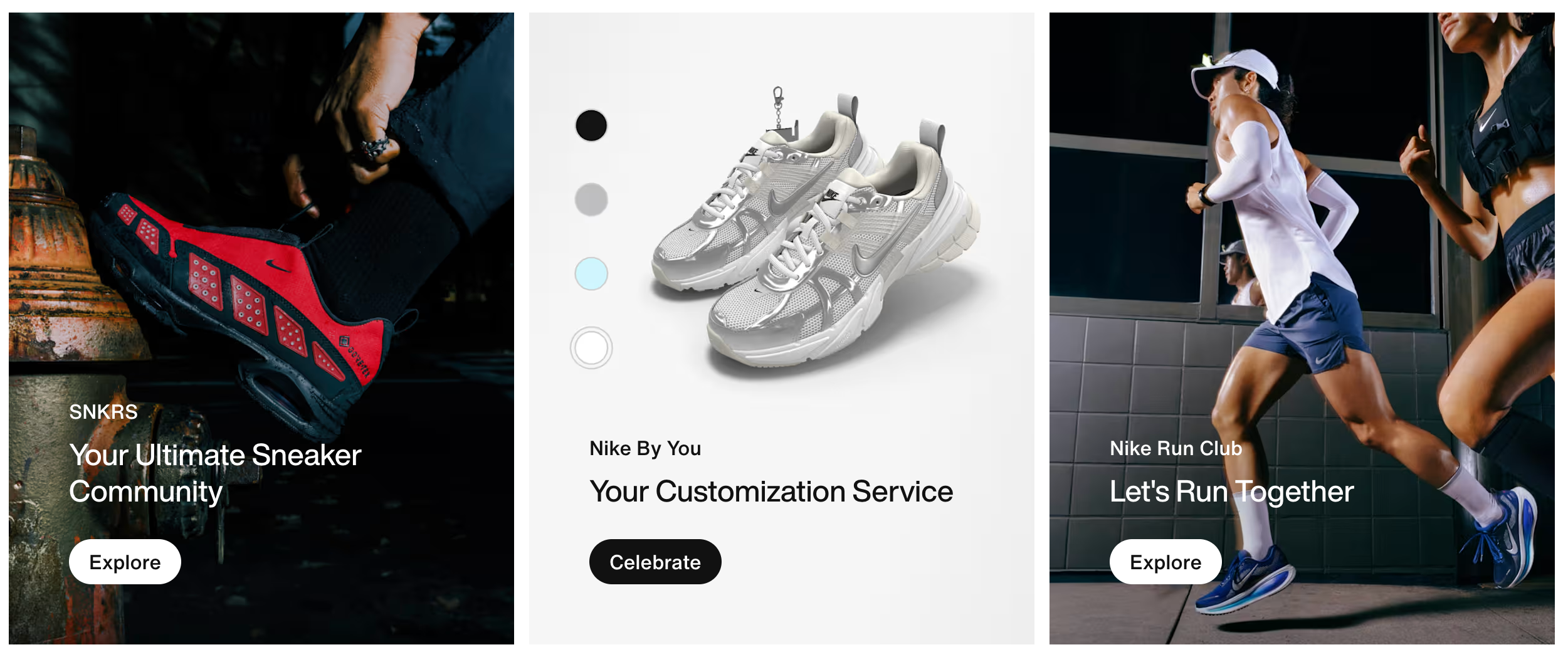
Best practices for tiered loyalty programs
Building a tiered loyalty program that genuinely drives engagement takes more than stacking rewards or naming a few shiny tiers. The best programs feel intentional: they balance clarity, motivation, and emotion, all powered by smart use of customer data.
Below are some proven best practices to help you design a program that keeps members climbing, engaging, and coming back for more.
1. Make each tier feel meaningful and distinct
Each level in your program should feel like a real step up. If the difference between tiers is minimal, customers lose interest quickly. Create a clear sense of progression, whether that’s moving from basic perks like free shipping to more aspirational rewards such as VIP access, early product drops, or one-to-one experiences.
Think of your tiers as chapters in a story: each one should have its own tone, benefits, and excitement that make the next level worth chasing. People are wired to respond to progress. When rewards evolve in a tangible way, they reinforce the feeling of achievement that keeps customers invested.
2. Balance aspiration with attainability
Your program should make customers want to reach the next level, but also believe they can. If the gap between tiers feels impossible, motivation turns into frustration.
Use real customer data to set thresholds that are challenging yet realistic. Many successful programs include “quick wins” early on, such as small rewards or visible progress that hook users from the start. Once customers experience success, they’re far more likely to stay active.
3. Communicate progress clearly
Clarity keeps people moving forward. Members should always know where they stand, what they’ve earned, and how far they are from the next reward.
Visual cues, like progress bars, achievement badges, or milestone emails, make this effortless. Starbucks, for instance, shows exactly how many “Stars” are needed for a free drink, turning everyday purchases into visible progress.
4. Reward more than just transactions
Recognize and reward actions that strengthen brand connection: writing reviews, sharing on social media, attending events, or referring friends. These behaviors build advocacy and extend your reach organically.
Rewarding engagement shows you value the relationship, not just the revenue. It deepens emotional loyalty and keeps your brand top of mind even when customers aren’t buying.
5. Personalise rewards using data
Use behavioral and transactional data to tailor rewards, messaging, and experiences. A frequent online shopper might prefer free delivery, while an in-store customer could value early access to local events.
Platforms like White Label Loyalty make this easy with event-based loyalty engines that let brands assign points or tier progress to any action, from purchases to app engagement to offline interactions.
6. Keep the structure simple and transparent
Complexity kills engagement. Too many tiers or confusing rules make customers tune out before they even start.
Stick to a clear structure, typically three or four tiers, and communicate the criteria in plain language. A simple “spend X to unlock Y” is far more motivating than a dense chart of conditions.

How White Label Loyalty can help
Designing and managing a successful tiered loyalty program based loyalty programs can be complex, especially when you want flexibility, real-time insights, and full control over how customers earn and progress. That’s where White Label Loyalty makes the difference with features like card linking.
Our modular, event-based loyalty platform lets brands create fully customizable tier structures that reward any type of engagement, not just transactions. Whether you want to recognise spending, social actions, referrals, or in-app behaviour, you can design a program that reflects your business goals and customer journey.
With real-time analytics, you can track tier progression, identify your most valuable members, and adjust rewards instantly to maximise engagement. From simple to sophisticated tiered models, our platform gives you the tools to build, test, and optimise every stage of your loyalty experience, without code or complexity.
Frequently Asked Questions (FAQs)
How does a tiered loyalty program work?
Tiered loyalty programs work by assigning loyalty points to customers at different levels according to their activity, such as purchases, referrals, or other engagement behaviors. Each tier comes with its own set of rewards. As customers continue to interact with the brand, they progress through the tiers and access greater benefits, turning everyday engagement into a rewarding journey.
Why are tiered loyalty programs effective?
They’re effective because they use psychological motivation. Top tier customers are driven by progress and status, seeing how close they are to the next tier encourages repeat purchases and long-term engagement. Tiered programs also help brands recognize and retain their most valuable customers while motivating others to increase their participation.
What should you avoid when creating a tiered loyalty program?
Avoid making tiers too difficult to reach or too similar to each other. Overly complex rules or unclear communication can also discourage participation. Successful programs balance aspiration and attainability, customers should always feel the next reward is within reach.
What’s the difference between tiered and non-tiered loyalty programs?
A tiered loyalty program uses levels or ranks to reward customers as they progress. A non-tiered program usually offers the same rewards to everyone, such as earning points or cashback. Tiered systems are better for building long-term motivation and rewarding loyalty depth, while non-tiered models are simpler to manage but less personalized.
Conclusion
Tiered loyalty programs remain one of the most effective ways to build lasting customer relationships. The way that they combine clear progression, meaningful rewards, and emotional recognition can turn casual buyers into long-term brand advocates.
The best programs are simple, data-driven, and designed around real customer behaviour. They create motivation, belonging, and a sense of achievement that keeps members engaged for the long term.
Whether you’re looking to launch your first program or optimise an existing one, White Label Loyalty provides the tools and insights to make it happen. Our flexible platform helps brands design tiered loyalty experiences that grow with their customers, and deliver measurable business impact.
👉 Book a demo to discover how you can build a tiered loyalty program that drives engagement, retention, and revenue.
Recommended Posts
If you enjoyed this article, check out these relevant posts below.
Share this Article
Sara Rabolini
Content Marketing Executive
Sara is our Content Marketing Executive. She shares engaging and informative content, helping businesses stay up-to-date with the latest trends and best practices in loyalty...